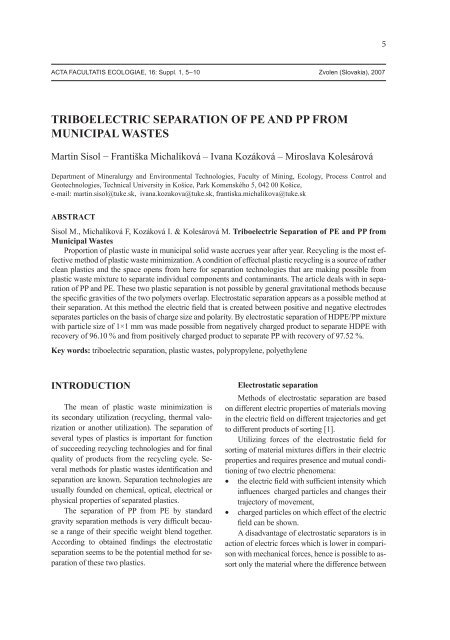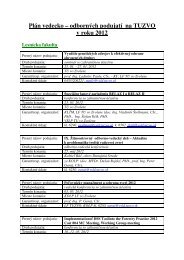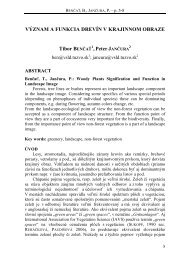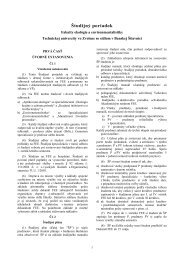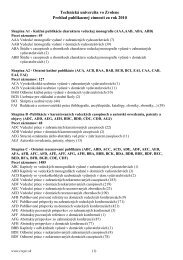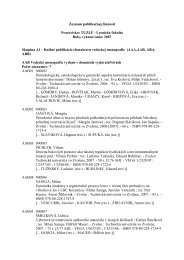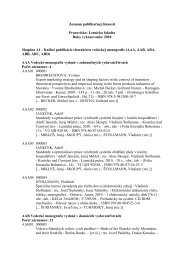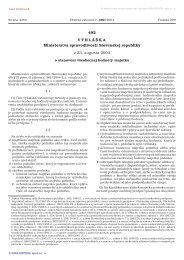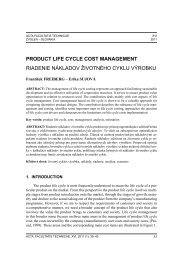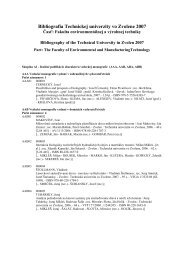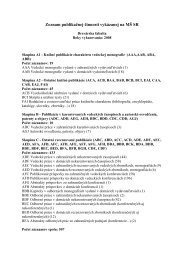Acta Facultatis Ecologiae - Technická univerzita vo Zvolene
Acta Facultatis Ecologiae - Technická univerzita vo Zvolene
Acta Facultatis Ecologiae - Technická univerzita vo Zvolene
- No tags were found...
Create successful ePaper yourself
Turn your PDF publications into a flip-book with our unique Google optimized e-Paper software.
5ACTA FACULTATIS ECOLOGIAE, 16: Suppl. 1, 5 – 10 Z<strong>vo</strong>len (Slovakia), 2007TRIBOELECTRIC SEPARATION OF PE AND PP FROMMUNICIPAL WASTESMartin Sisol − Františka Michalíková – Ivana Kozáková – Miroslava KolesárováDepartment of Mineralurgy and Environmental Technologies, Faculty of Mining, Ecology, Process Control andGeotechnologies, Technical University in Košice, Park Komenského 5, 042 00 Košice,e-mail: martin.sisol@tuke.sk, ivana.kozakova@tuke.sk, frantiska.michalikova@tuke.skABSTRACTSisol M., Michalíková F, Kozáková I. & Kolesárová M. Triboelectric Separation of PE and PP fromMunicipal WastesProportion of plastic waste in municipal solid waste accrues year after year. Recycling is the most effectivemethod of plastic waste minimization. A condition of effectual plastic recycling is a source of ratherclean plastics and the space opens from here for separation technologies that are making possible fromplastic waste mixture to separate individual components and contaminants. The article deals with in separationof PP and PE. These two plastic separation is not possible by general gravitational methods becausethe specific gravities of the two polymers overlap. Electrostatic separation appears as a possible method attheir separation. At this method the electric field that is created between positive and negative electrodesseparates particles on the basis of charge size and polarity. By electrostatic separation of HDPE/PP mixturewith particle size of 1×1 mm was made possible from negatively charged product to separate HDPE withrecovery of 96.10 % and from positively charged product to separate PP with recovery of 97.52 %.Key words: triboelectric separation, plastic wastes, polypropylene, polyethyleneINTRODUCTIONThe mean of plastic waste minimization isits secondary utilization (recycling, thermal valorizationor another utilization). The separation ofseveral types of plastics is important for functionof succeeding recycling technologies and for finalquality of products from the recycling cycle. Severalmethods for plastic wastes identification andseparation are known. Separation technologies areusually founded on chemical, optical, electrical orphysical properties of separated plastics.The separation of PP from PE by standardgravity separation methods is very difficult becausea range of their specific weight blend together.According to obtained findings the electrostaticseparation seems to be the potential method for separationof these two plastics.Electrostatic separationMethods of electrostatic separation are basedon different electric properties of materials movingin the electric field on different trajectories and getto different products of sorting [1].Utilizing forces of the electrostatic field forsorting of material mixtures differs in their electricproperties and requires presence and mutual conditioningof two electric phenomena:• the electric field with sufficient intensity whichinfluences charged particles and changes theirtrajectory of movement,• charged particles on which effect of the electricfield can be shown.A disadvantage of electrostatic separators is inaction of electric forces which is lower in comparisonwith mechanical forces, hence is possible to assortonly the material where the difference between


